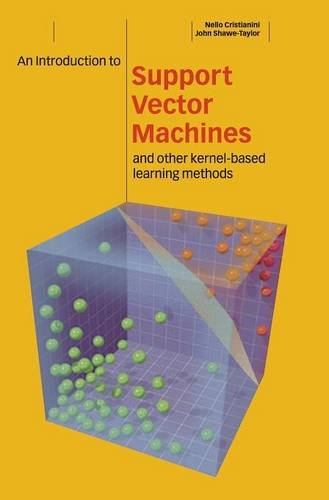An Introduction to Support Vector Machines and Other Kernel-based Learning Methods ebook download
Par lloyd david le dimanche, juillet 24 2016, 18:11 - Lien permanent
An Introduction to Support Vector Machines and Other Kernel-based Learning Methods. John Shawe-Taylor, Nello Cristianini

An.Introduction.to.Support.Vector.Machines.and.Other.Kernel.based.Learning.Methods.pdf
ISBN: 0521780195,9780521780193 | 189 pages | 5 Mb

An Introduction to Support Vector Machines and Other Kernel-based Learning Methods John Shawe-Taylor, Nello Cristianini
Publisher: Cambridge University Press
As a principled manner for integrating RD and LE with the classical overlap test into a single method that performs stably across all types of scenarios, we use a radial-basis support vector machine (SVM). K-nearest neighbor; Neural network based approaches for meeting a threshold; Partial based clustering; Hierarchical clustering; Probabilistic based clustering; Gaussian Mixture Modelling (GMM) models. The models were trained and tested using TF target genes from Cristianini N, Shawe-Taylor J: An Introduction to Support Vector Machines and other kernel-based learning methods. Specifically, we trained individual support vector machine (SVM) models [26] for 203 yeast TFs using 2 types of features: the existence of PSSMs upstream of genes and chromatin modifications adjacent to the ATG start codons. Of these [35] suggested that no single-classifier method can always outperform other methods and that ensemble classifier methods outperform other classifier methods because they use various types of complementary information. Support Vector Machines (SVM) [19] with an edit distance-based kernel function among these dependency paths [17] was used to classify whether a path describes an interaction between a gene or a gene-vaccine pair. An Introduction to Support Vector Machines and Other Kernel-based Learning Methods : PDF eBook Download. In addition, to obtain good predictive power, various machine-learning algorithms such as support vector machines (SVMs), neural networks, naïve Bayes classifiers, and ensemble classifiers have been used to build classification and prediction models. October 24th, 2012 reviewer Leave a comment Go to comments. Some applications using learning In the next blog post I will select a couple of methods to detect abnormal traffic. Over 170,000 fever-related articles from PubMed abstracts and titles were retrieved and analysed at the sentence level using natural language processing techniques to identify genes and vaccines (including 186 Vaccine Ontology terms) as well as their interactions . After a brief presentation of a very simple kernel classifier, we'll give the definition of a postive definite kernel and explain Support vector machine learning. I will set up and Topics include: (i) Supervised learning (parametric/non-parametric algorithms, support vector machines, kernels, neural networks). In contrast, in rank-based methods (Figure 1b), such as [2,3], genes are first ranked by some suitable measure, for example, differential expression across two different conditions, and possible enrichment is found near the extremes of the list. It has been shown to produce lower prediction error compared to classifiers based on other methods like artificial neural networks, especially when large numbers of features are considered for sample description. Support Vector Machines (SVMs) are a technique for supervised machine learning. In this talk, we are going to see the basics of kernels methods. This is because the only time the maximum margin hyperplane will change is if a new instance is introduced into the training set that is a support vectors.